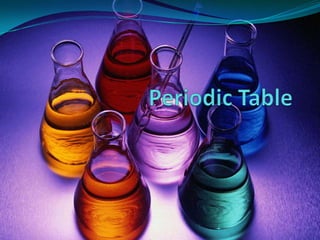Empfohlen
Empfohlen
Weitere ähnliche Inhalte
Was ist angesagt?
Was ist angesagt? (19)
Ch 5.1,5.2 organizing elements & the periodic table

Ch 5.1,5.2 organizing elements & the periodic table
Ähnlich wie Periodic table
Ähnlich wie Periodic table (20)
Periodic calssification of elements ncert shashikumar b s

Periodic calssification of elements ncert shashikumar b s
Chapter - 5, Periodic Classification of Elements, Science, Class 10

Chapter - 5, Periodic Classification of Elements, Science, Class 10
Kürzlich hochgeladen
Kürzlich hochgeladen (20)
WSO2's API Vision: Unifying Control, Empowering Developers

WSO2's API Vision: Unifying Control, Empowering Developers
Mcleodganj Call Girls 🥰 8617370543 Service Offer VIP Hot Model

Mcleodganj Call Girls 🥰 8617370543 Service Offer VIP Hot Model
Apidays New York 2024 - Accelerating FinTech Innovation by Vasa Krishnan, Fin...

Apidays New York 2024 - Accelerating FinTech Innovation by Vasa Krishnan, Fin...
Polkadot JAM Slides - Token2049 - By Dr. Gavin Wood

Polkadot JAM Slides - Token2049 - By Dr. Gavin Wood
Why Teams call analytics are critical to your entire business

Why Teams call analytics are critical to your entire business
Cloud Frontiers: A Deep Dive into Serverless Spatial Data and FME

Cloud Frontiers: A Deep Dive into Serverless Spatial Data and FME
How to Troubleshoot Apps for the Modern Connected Worker

How to Troubleshoot Apps for the Modern Connected Worker
Boost Fertility New Invention Ups Success Rates.pdf

Boost Fertility New Invention Ups Success Rates.pdf
Navigating the Deluge_ Dubai Floods and the Resilience of Dubai International...

Navigating the Deluge_ Dubai Floods and the Resilience of Dubai International...
Elevate Developer Efficiency & build GenAI Application with Amazon Q

Elevate Developer Efficiency & build GenAI Application with Amazon Q
Finding Java's Hidden Performance Traps @ DevoxxUK 2024

Finding Java's Hidden Performance Traps @ DevoxxUK 2024
Vector Search -An Introduction in Oracle Database 23ai.pptx

Vector Search -An Introduction in Oracle Database 23ai.pptx
EMPOWERMENT TECHNOLOGY GRADE 11 QUARTER 2 REVIEWER

EMPOWERMENT TECHNOLOGY GRADE 11 QUARTER 2 REVIEWER
Apidays New York 2024 - The Good, the Bad and the Governed by David O'Neill, ...

Apidays New York 2024 - The Good, the Bad and the Governed by David O'Neill, ...
Periodic table
- 2. Introduction Now a days scientist had found 116 elements which have their own symbol and 92 elements are natural and 24 elements are artificial. About 150 years ago scientist were trying to group elements together but they failed. In 1869 one scientist name Mendeleyev had found a best method to group those elements base on their atomic number and known as “Periodic Table”.
- 3. Periodic Table Periodic table is a tabular display of the chemical elements, organized on the basis of their atomic numbers, electron configurations, and recurring chemical properties. In 1860 more than 100 European scientist met for the first time to decide how to group how to organise the elements including Alexander Chancourtois, Dmitri Mendeleyev, Henry Moseley, Johann Dobereiner, John Newlands and Lothan Meyer.
- 4. Sir William Crooks atomic model Dmitri Medeleyev John D. Clarck Different designs prepared for the periodic table
- 6. Grouping Elements Periodic table are divided into 18 groups and 7 periods. Energy level of elements increase from top to bottom of the periodic table and atomic number of the elements increase from left to right, top to bottom of the periodic table. Many elements in the periodic table are metals. Other are non metal and metalloid. Metalloid is an element with properties intermediate between those of a metal and non metal. For example: silicon, boron and germonium.
- 7. Group A group is a vertical column in the periodic table. Elements which is in same group have similar characteristic. They also have same number of electron. From top to bottom in a group, the atomic radii of the elements increase.
- 8. Period A period is a horizontal row in the periodic table. There are 7 periods in periodic table. Elements in the same period show trends in atomic radius, ionization energy, electron affinity, and electronegativity. Moving left to right across a period, atomic radius usually decreases.
- 9. How to read an elements in periodic table
- 10. Metal 70 % of the elements in periodic table are metal. They occupy the left-hand side of the periodic table. Characteristic of metal: • They are shiny • They conduct electricity and heat well • They are found as solid at room temperature • They lose electrons easily • They can hammered into shape • They can be pulled into the shape of wires • They don’t form compounds with each other.
- 11. Non metal Characteristic of non metal: • Rarely have metallic luster (shine) • Generally gases at room temperature • Neither malleable nor ductile • Brittle and dull • Poor conductors of heat and electricity • Usually exist as molecules in their elemental form • Combine with other nonmetals to form covalent • Generally form negative ions, e.g. Cl-, SO4 2-, and N3- • High electronegativity • High ionization energy • Small atom size • Gain electrons to complete their octet • Low boiling and heating points • Mostly in liquid or gas form

